A while back Larry
Breazeale wrote an article about his time at Biên Hòa AB (Apr
97). After reading it, I thought I should write a follow-up since
it turns out we were there at the same time, although we worked different
areas and didn't know each other.
But first, let's back up a few months before
I arrived in-country. Imagine a bright, sunny day in the high-desert
at George AFB, California, in January 1969. I'm on leave helping my
wife get settled at home with our daughter who was just three days
old. After running errands, I got home to find my wife with our baby
in her arms and tears in her eyes. She says, "You'd better call
Sgt Miller, you got orders.
At first I thought I couldn't be going anywhere.
I'd been at George so long; I told everyone I was "homesteading."
Sgt Miller told me I was going to the 3rd SPS at Biên Hòa AB, RVN,
and had to report on May 1. So, after taking more leave-time and to
AZR schools back at Lackland, the next three months went by in a flash.
Before I knew it, I was saying goodbye to my family and getting on
a plane at Travis AFB... next stop Biên Hòa and the start of my Vietnam
adventure.
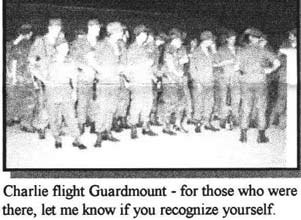 I arrived at Biên Hòa in the middle of the day with the sun shining
through an overcast sky. I felt somewhat at home with the heat, after
spending two and a half years in the Mojave Desert of California.
I arrived at Biên Hòa in the middle of the day with the sun shining
through an overcast sky. I felt somewhat at home with the heat, after
spending two and a half years in the Mojave Desert of California.
Of course, that only lasted until I realized there was no air moving
and the humidity level was close to 100 percent. It didn't take long
before I was complaining, like everyone else, about it being cold
when it got down in the 70's at night--that was cold compared to the
ll0+ degree heat and 90%+ percent humidity of the daytime.
My first weeks in-country as a FNG were fairly routine and uneventful.
They were filled with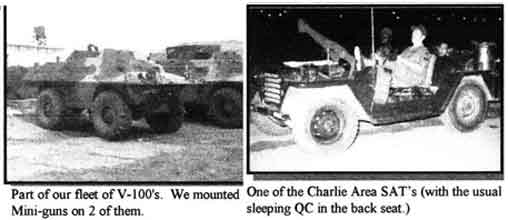 the usual base orientation including the SP compound, tour of the
perimeter and several days of additional weapons training with the
.50 cal., 90 mm, Claymore, etceteras.
the usual base orientation including the SP compound, tour of the
perimeter and several days of additional weapons training with the
.50 cal., 90 mm, Claymore, etceteras.
Although it seemed routine after
a while, it wasn't until my twelfth day in-country that Charlie welcomed
me. This welcome (of course) came in the form of five 122mm rockets
slamming into the base at 1:22 in the morning. They were only slightly
preceded by that siren that I still hate to this day, and people running
through the hooch yelling, "incoming, incoming!" Did you
ever notice how that damn siren always wailed for what seemed like
hours after the last rocket hit?
Even after I came home, I was
reminded of these times in Vietnam. The Marysville Volunteer Fire
Department near Beale AFB, California provided my first reminder.
They used the local air raid system to a the fire fighters. We laughed
about it later, but at first my wife couldn't figure out what I was
doing when I rolled out of bed and tried to get under it at about
3 a.m. one morning. When she heard the siren in the distance, she
told me it was okay and explained what was happening. Even in 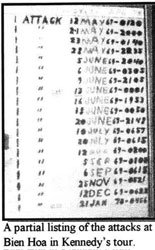 all my years in law enforcement since then police, fire or ambulance
sirens have never bothered me. However, I still flinch when I hear
an air raid type siren start to wail. Minor case of PTSD I guess.
all my years in law enforcement since then police, fire or ambulance
sirens have never bothered me. However, I still flinch when I hear
an air raid type siren start to wail. Minor case of PTSD I guess.
Before I got there, I had
heard the stories about Biên Hòa: the 1968 Tet Offensive, Bunker Hill-10 and Captain Reginald V. Maisey, who was killed by an RPG at
that old French bunker on January 31, 1968. So, if there was anyplace
that I knew I wanted to avoid, that was the place.
However, when I think of it there were several things I
wanted to avoid, not the least of which was being in Vietnam, much
less at Biên Hòa Air Base. When I was a FNG, I thought it would be better
to work during the day, so I could see what I was fighting. I knew
I didn't want to work nights (Charlie Flight); I didn't want to work
the east perimeter (Charlie Area); I certainly didn't want to work
Bunker Hill-10. Well, my first night on post I really thought someone
was out to get me (besides
Charlie).
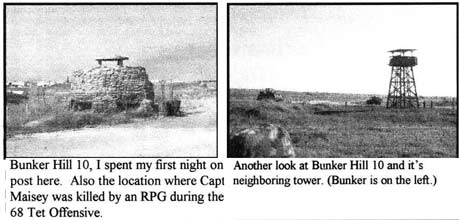 If you haven't guessed... my first assignment was Charlie Flight,
Charlie Area, Bunker Hill-10. As it turned out I spent quiet a bit
of time there during my first couple of months in-country. I also
found that I really preferred being awake when the rockets came.
If you haven't guessed... my first assignment was Charlie Flight,
Charlie Area, Bunker Hill-10. As it turned out I spent quiet a bit
of time there during my first couple of months in-country. I also
found that I really preferred being awake when the rockets came.
From Bunker Hill-10, I graduated to SATS. While the primary
duty of our SATs was to be mobile patrol and response force, I'm sure
like many other bases; we spent most of our time playing "Winchells
on Wheels. We always went to the Army's 145th Aviation Battalion
mess hall to scrounge what we could for the troops working the bunkers
and towers because we seemed to have an easier time getting food from
the army cooks.
When I first got to Biên Hòa, the 3rd SPS had a fleet of seven Ducks (V-100s) and one old gas
powered M-113 APC. During the summer of 1969, we received four new
diesel powered APCs. Shortly after, we gave the old "gasser"
to the army. We later heard they dropped a diesel into it and on it's
first mission in the field, it was destroyed and the crew killed when
an RPG hit it.
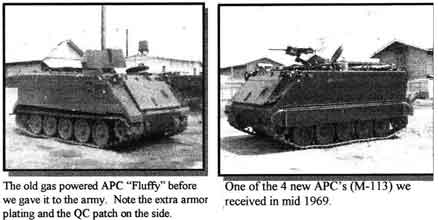 Anyway, I was soon trained to
drive the new M113s and found myself spending most of my time running
a QRT in Charlie area. It was strange learning to steer by pulling
sticks instead of turning a wheel, but I soon got the hang of it and
was an expert at popping donuts in no time. Although we had the armored
vehicle, our manpower was such that we rarely had little more [personnel]
on our APCs (usually 4-5) versus the usual 3 on a SAT. I can only
remember a couple times when we had more people on our QRT. Once was
when we went on alert during the Tet holiday in January of 1970, when
we had just eight people on the team.
Anyway, I was soon trained to
drive the new M113s and found myself spending most of my time running
a QRT in Charlie area. It was strange learning to steer by pulling
sticks instead of turning a wheel, but I soon got the hang of it and
was an expert at popping donuts in no time. Although we had the armored
vehicle, our manpower was such that we rarely had little more [personnel]
on our APCs (usually 4-5) versus the usual 3 on a SAT. I can only
remember a couple times when we had more people on our QRT. Once was
when we went on alert during the Tet holiday in January of 1970, when
we had just eight people on the team.
The other time was during President
Richard Nixon's visit to Vietnam, which was a long and boring day.
I remember my team was one of several pulled from our regular night-watch
duties and deployed during the day as additional perimeter security
in preparation for the visit. My team, with several augmentees and
a SP lieutenant along with a second APC, was positioned on a small
village road outside the west perimeter fence, about two hundred yards
off the end of the runway. Our job was to block the roads on either
side of the runway approach and provide a secure path as Air Force
One landed at Biên Hòa. I remember we sat there for something
like l2 hours waiting for Nixon's plane to arrive. Not only was it
a long boring day, but President Nixon's plane never came closer than
10-20,000 feet above, as it flew over us and landed at Tan Son Nhut.
All we got were two of the President's F-4 Phantom fighter-escorts
and sunburns. We did a hell of a job protecting that road though.
As Larry speculated, we did in
fact mount mini-guns on a couple of our V-100s. This was just one
of a number of improvised weapons or defensive Systems developed by
Air/Security Police in Vietnam, many of which originated at Biên Hòa.
As I'm sure many of you saw, Vietnam
was probably the largest test lab (up to that point in history) for
tactics and weapons. In one case, my QRT participated in one of the
initial deployments of one of these new weapons systems, the XM-174
automatic grenade launcher. We were called into the armory one night
and issued this new weapon with several magazines. It would use the
same mount on our APC as the M60. So, after mounting the weapon,
we headed back out to our area, before we got two blocks away, it
broke and we had to take it back for repair. I know for a time after
that, the XM-174 was always transported on someone's lap and mounted
after arriving on post. When it worked, it was great and because of
the automatic feed, it could lay down a perfect pattern of grenades.
I was at Biên Hòa when President
Nixon instituted his "Vietnamization Program." While we
understood what was intended, it really created some problems for
SP's trying to protect bases. I don't know how things were after I
left, but it was crazy at first. As part of the efforts to wind down
U.S. involvement in the war and save money, we were even told at one
point that we had to have a confirmed target before we could put up
a slap flare. A lot of guys had a hard time with this because it was
often difficult to know if you had a target without putting up a flare
so you could see what was there.
Because Biên Hòa City was off
limits, my entire tour of duty in Vietnam was spent on base except
for a bus ride to Tan Son Nhut for my R&R flight, a four hour
trip to Long Vinh in an attempt to get Comm-Gear for our new APC's;
and that wonderful day off the west perimeter on top of my APC.
I was lucky enough not to have
to defend against a ground assault, but I did experience more than
20 rocket attacks, a mortar attack and unfortunately, two friendly
fire incidents. On one occasion, an Army fire-base several miles northeast
of us got bad coordinates for a fire mission. They walked two rounds
each of 105mm, 155mm and 175mm Willie-Pete across the east Perimeter
towards where my SAT was delivering coffee to a tower next to Bunker Hill-10. The last round landed about 100 feet across the perimeter
road from us. You can bet the pucker factor was in full force
then. Luckily no one got hurt.
The other incident; however, had
deadly results. In this case, the III Corps ARVN Special Forces fire-base
on our southeast perimeter fired two 105mm HE rounds directly north
over my QRT's position near the end of the runway. The rounds impacted
inside the Army's 101st Airborne area, killing several
soldiers. To make matters worse, 3 hours later, after an investigation
of the incident, they fired the same gun again, hit the same target,
killing and wounding more soldiers. We were on a sandbag detail at
the time and hit the dirt because the rounds were fired so low; they
sounded like they were coming in on us.
My Vietnam adventure may not be
as glamorous as some or as frightening as others, but an "adventure"
nonetheless and a proud part of my memory. In fact, it seems that
my service in Vietnam and as a Security Policeman has actually become
more important to me over the years and has furnished me with memories
and friends, some new, that will last a lifetime.
My last memory of Biên Hòa AB
was getting on my "Freedom Bird' and taking off, ironically over
my first post, Bunker Hill-10, on the east perimeter.